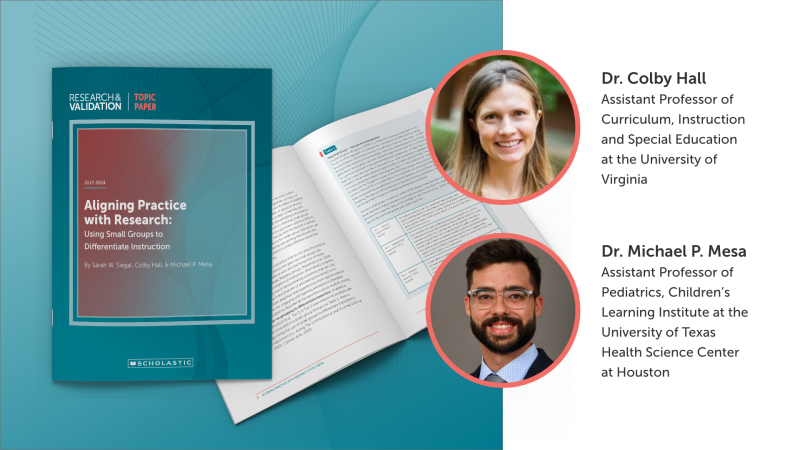In the first post of this blog series, we introduced the importance and positive impact of small-group instruction drawn from Scholastic Education’s Research & Validation Topic Paper entitled “Aligning Practice with Research: Using Small Groups to Differentiate Instruction."
We also discuss the critical role that administrators play in the success of small-group instruction.
This post will focus on high-level considerations that are necessary for creating small-group instruction strategies that allow students to see the full value of this important learning tactic.
Where to start
It is important to find the right balance between whole-class and small-group instruction, and to use small-group instructional time intentionally.
Small-group instruction facilitates both productive learning experiences and time to practice skills for all students in the classroom, not just those meeting directly with the teacher in a small group.
With this in mind, when determining how best to use small groups, schools should consider both the time students are working directly with the teacher as well as how to maximize effective use of their independent work time.
There are several questions which should be considered, including:
-
How should teachers group students, and how often should they update student groups?
-
What are the best ways to adjust instructional intensity, content, and methods to meet student needs?
-
What classroom routines best support effective small-group instruction?
The answers to these questions will identify and describe practices that support high-quality, small-group literacy instruction.
Understanding the four components of small-group instruction
As part of her larger body of work focused on understanding how different students learn best within the same classroom, Dr. Carol Connor wanted to determine the impact small group instruction had on student outcomes.
The research demonstrated that explicit, teacher-led instruction in foundational literacy skills and comprehension is necessary to ensure that students are proficient readers. It also showed that student agency in learning to read is important, particularly as they move beyond initial skill acquisition.
Connor and her colleagues identified four dimensions of instruction that—when provided in the appropriate, student-customized combination—maximize student growth in literacy.
-
Code-focused instruction is designed to teach children how to “crack the code” of printed words and addresses phonological awareness, grapheme-phoneme correspondence, phonics knowledge, decoding, and irregular word reading.
-
Meaning-focused instruction supports students’ efforts to extract and construct meaning while reading connected text and includes vocabulary knowledge, morpheme awareness, knowledge of print and text concepts, syntactic knowledge, and verbal reasoning
-
Teacher-managed instruction is structured and driven by the teacher, such that the teacher is continuously present with students.
-
Child-managed instruction during which students engage in group or independent work that is not directly guided by an adult; the teacher may occasionally check in and monitor work from afar, but they are not continuously present with students.
Use assessment to guide instruction
As explained in the first post of this series, instruction guided by assessments has been shown to raise the quality of instruction and improve student outcomes.
Using quantitative data and receiving training on how to use it effectively is also important because it helps reduce bias. Research has shown that teacher intuition and informal assessments alone do not always accurately capture a student’s academic competence.
When good data, collected using multiple methods and timepoints, is paired with training teachers can form a more complete picture of student strengths and needs for instruction planning and differentiation.
There are a few key factors to consider when using assessment data to guide instruction. First, for students at or above grade level who are continuing to make progress, informal assessment may be adequate for determining appropriate ways to differentiate instruction. In contrast, it may be necessary to administer multiple assessments to accurately determine the source of students’ trouble when they have difficulties.
Grouping students to differentiate instruction
Once teachers have used assessment data to identify areas of need, they can purposefully create:
-
Small groups of students with similar levels of knowledge and skill (homogeneous groups) to provide instruction that targets their shared areas of need, and/or
-
Small groups of students with differing levels of knowledge and skill (heterogeneous groups) to provide instruction that stretches students with stronger skills to be models or peer tutors and supports students with less skill to be learners.
Teachers can purposefully create homogeneous small groups based on various factors, including student interests, background knowledge, behavioral needs, and motivational levels.
Sometimes, a teacher will work with a subset of students with heterogeneous learning needs, motivational characteristics, or topics of interest with the goal of giving some students the opportunity to be models or teachers and other students opportunities to learn.
Student modeling may also offer an advantage over teacher-led demonstrations as peers often share learning experiences, ways of using language, and cultural knowledge.
Heterogeneous grouping has the collateral benefit of fostering interaction and collaboration among diverse groups of classmates—valuable skills that will help them throughout their education and careers.
Updating groups
Regularly updating small groups not only enables teachers to address the unique needs of each learner more effectively, but also fosters a more inclusive and collaborative learning environment.
Researchers recommend that teachers regularly update small-group composition to adapt to their students’ evolving needs as they respond to effective instruction.
It's also important to update small groups regularly to minimize the risk that ability labels will become entrenched.
When individual students demonstrate specific challenges not experienced by their classmates or require higher-intensity interventions, transitioning to a smaller group or even 1:1 instruction can be a strategic response.
The final post in this series will focus on the research that backs up the impact of small-group instruction. To read the full topic paper, click here.



